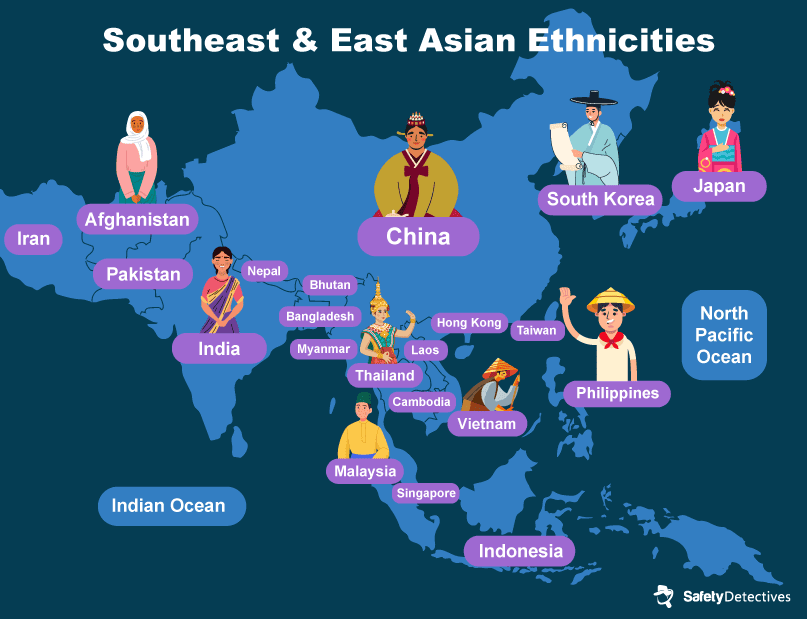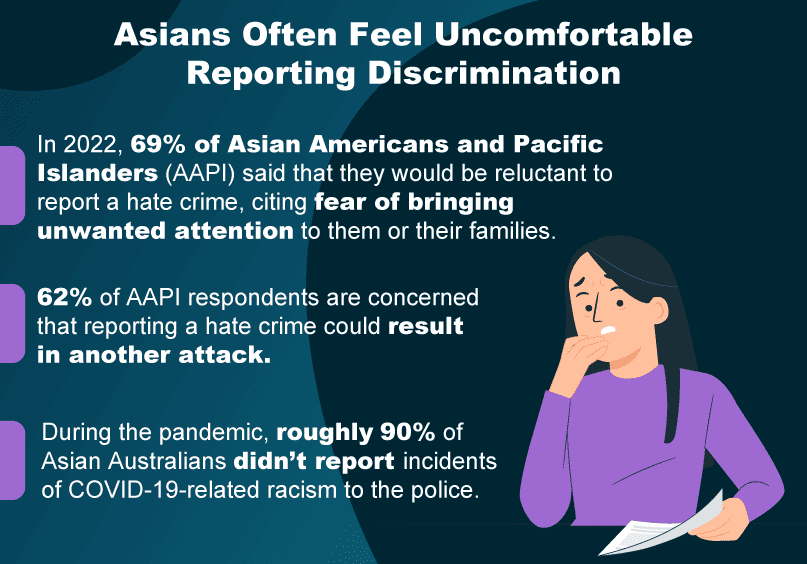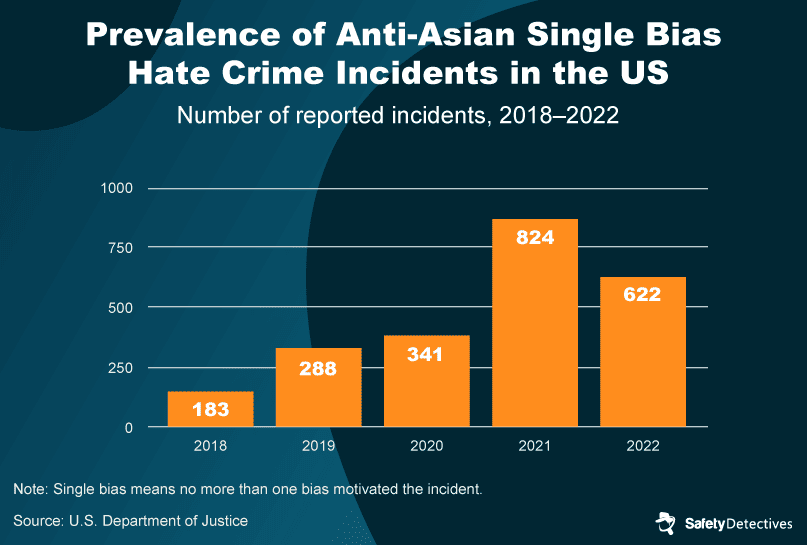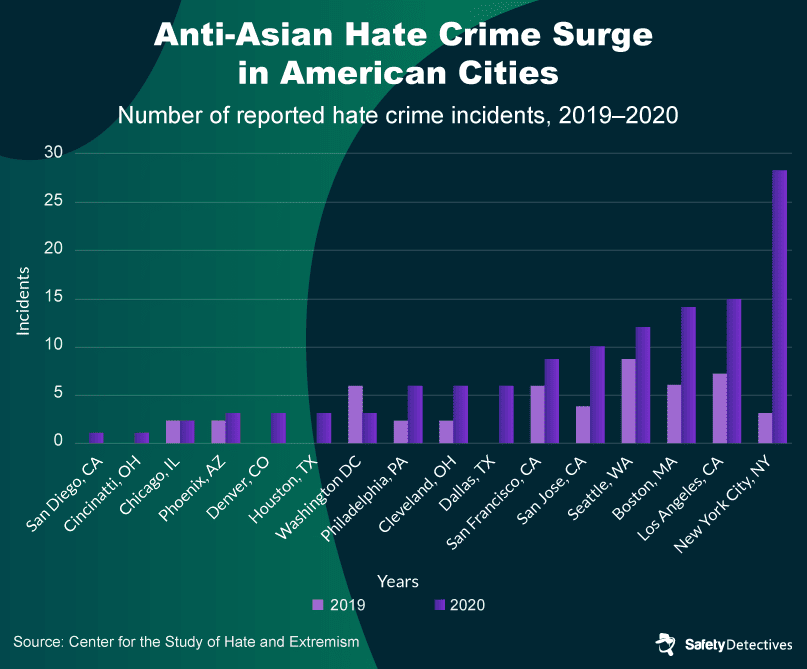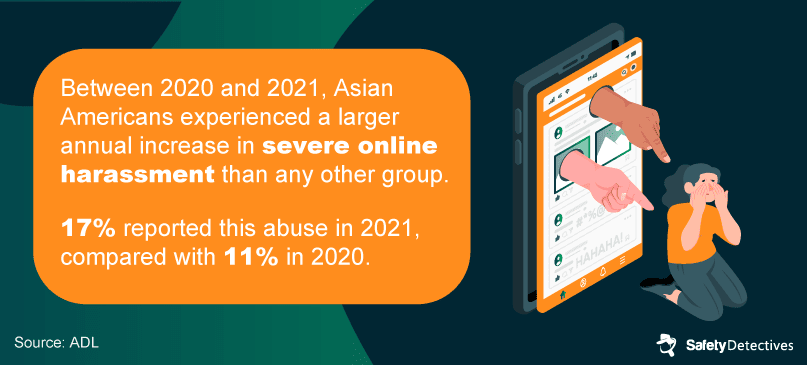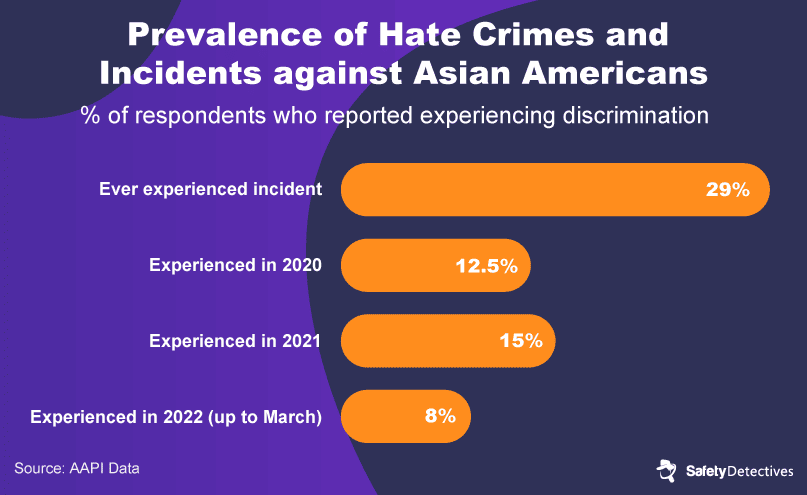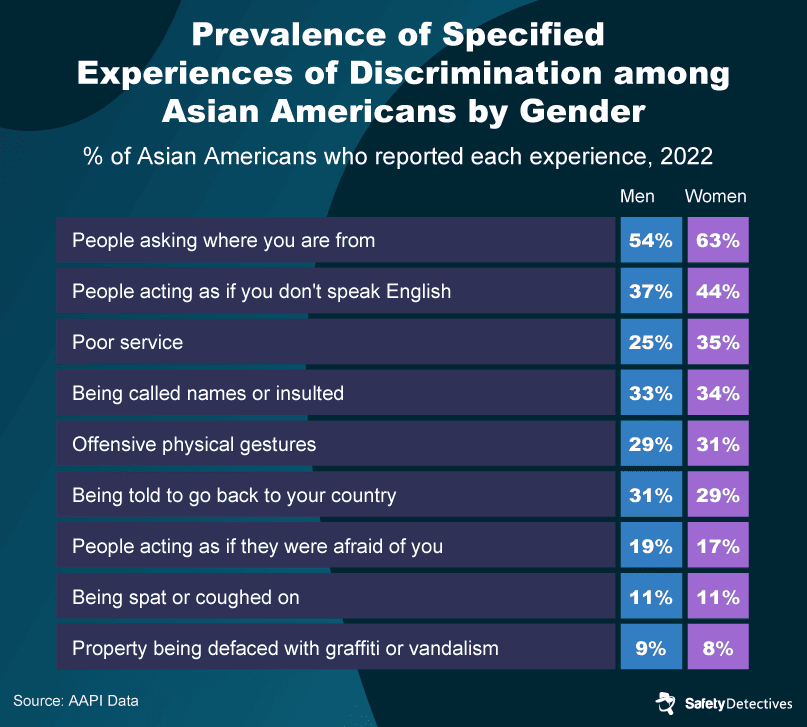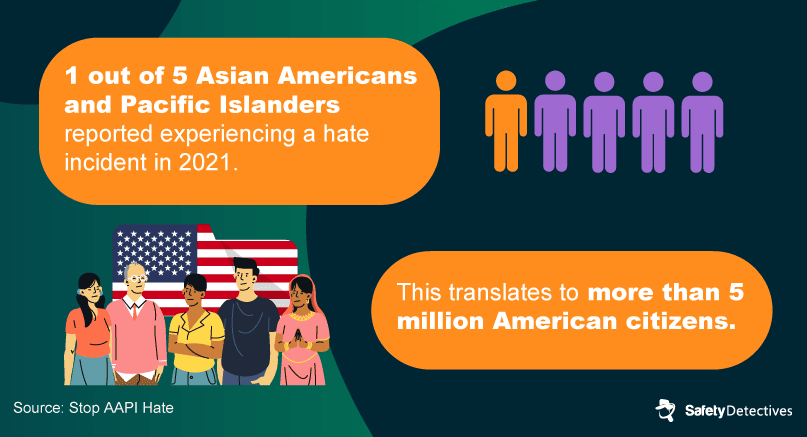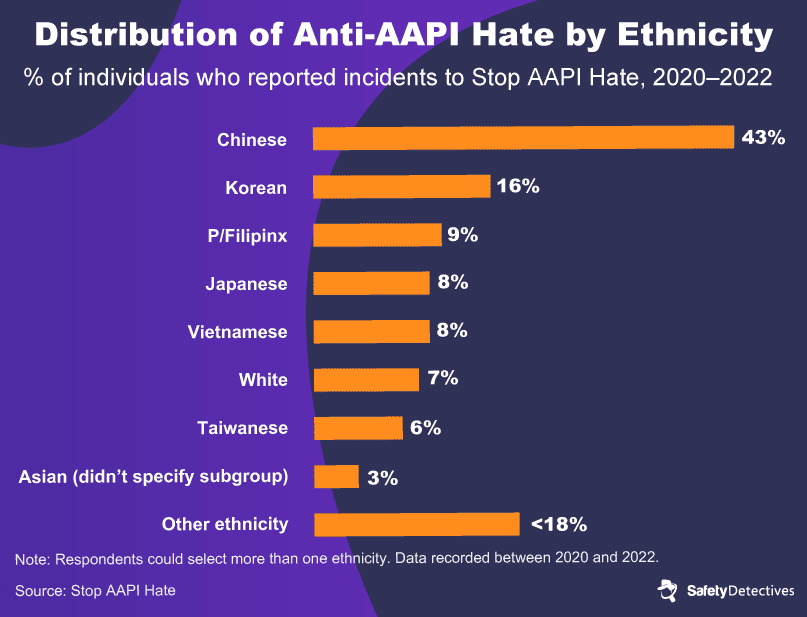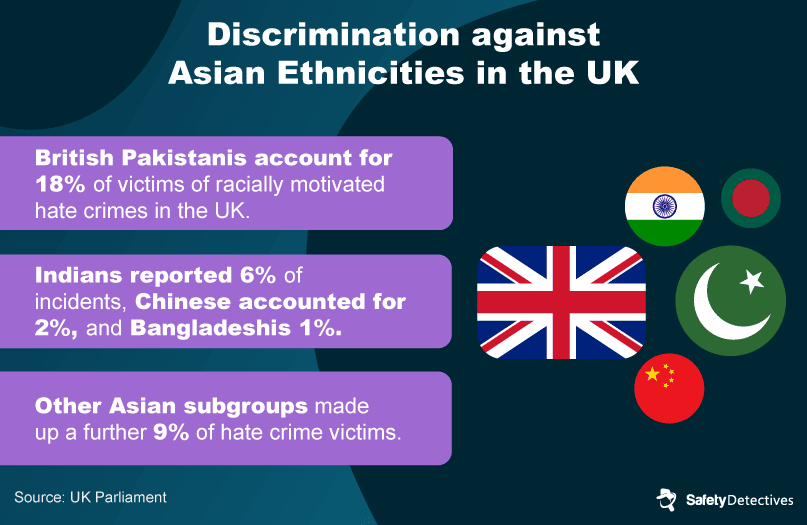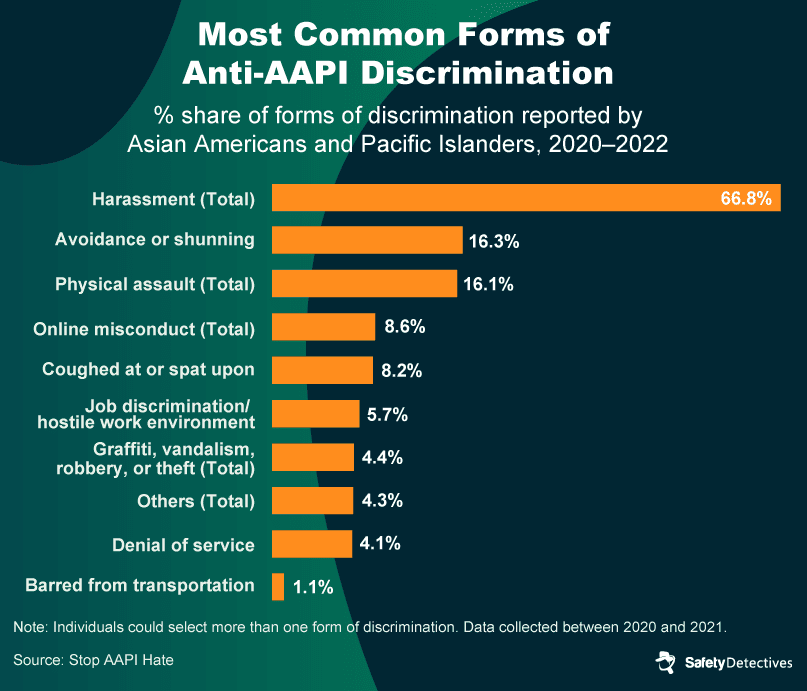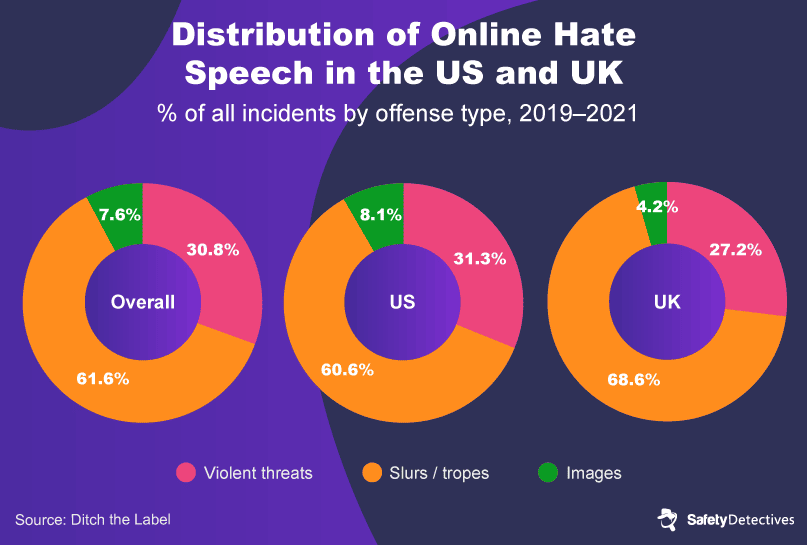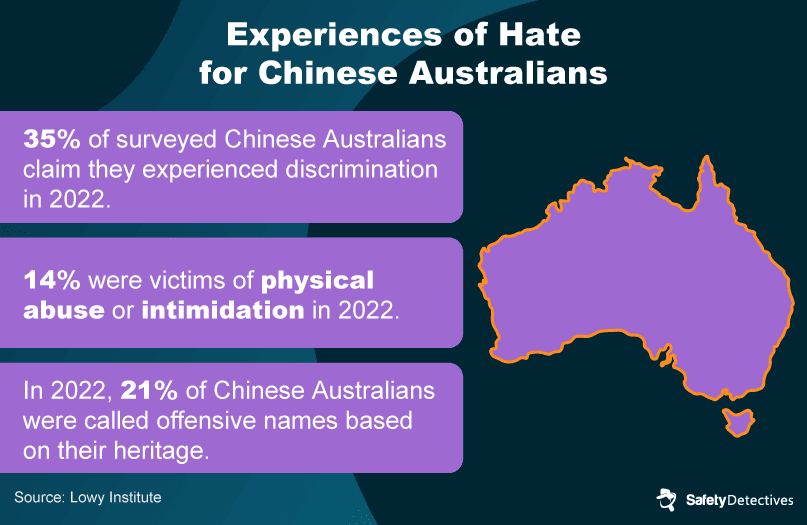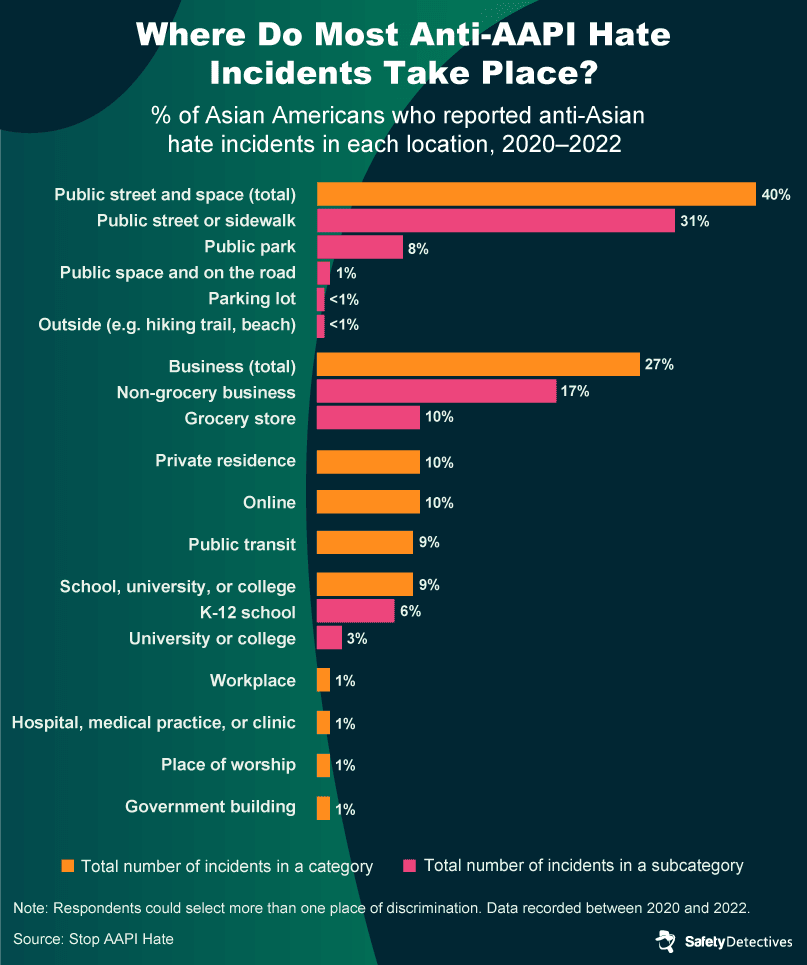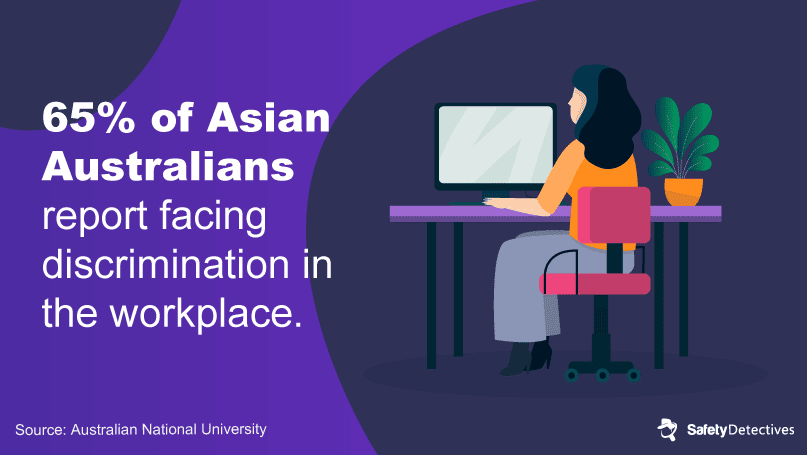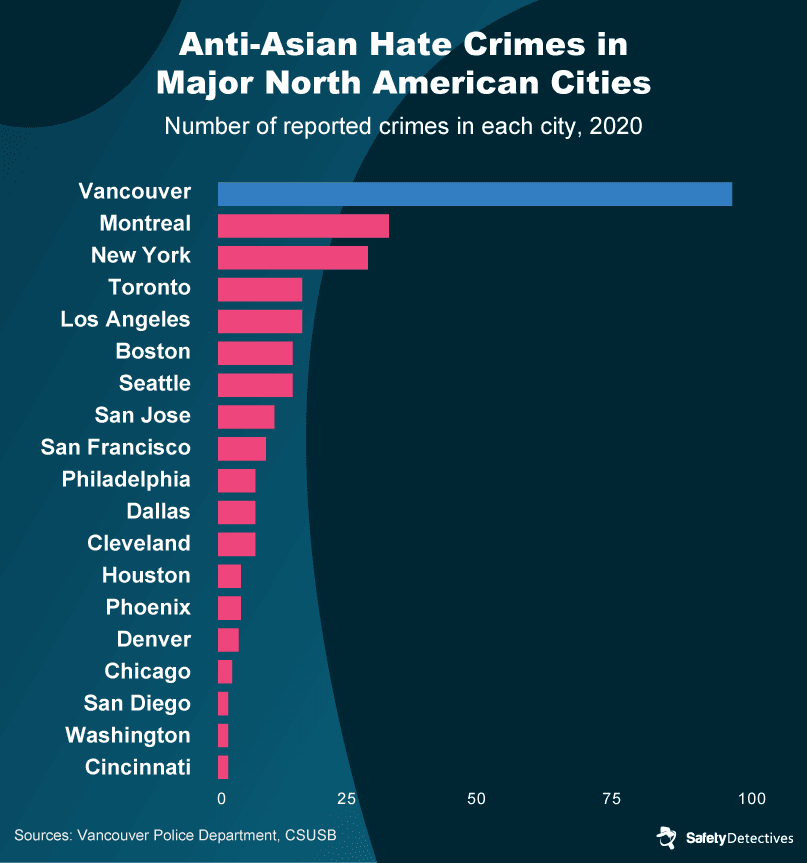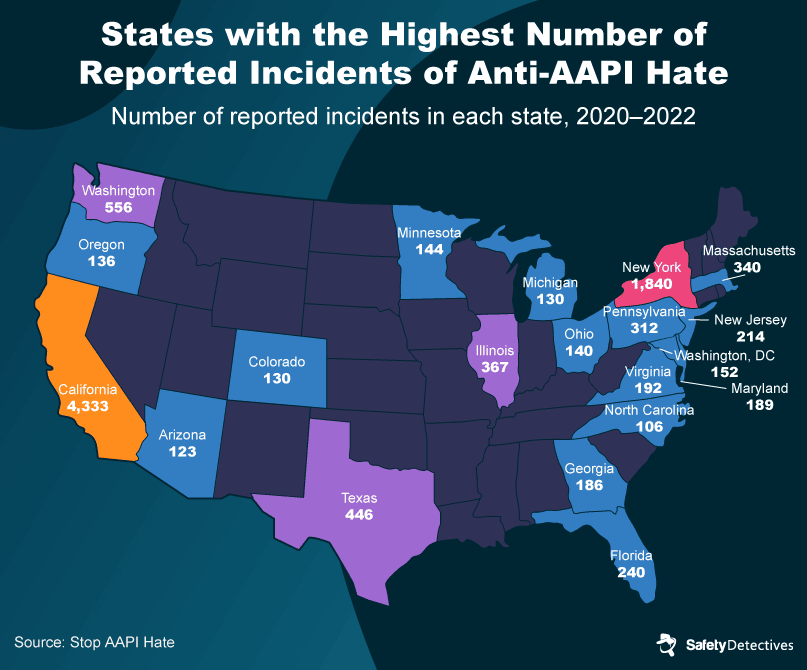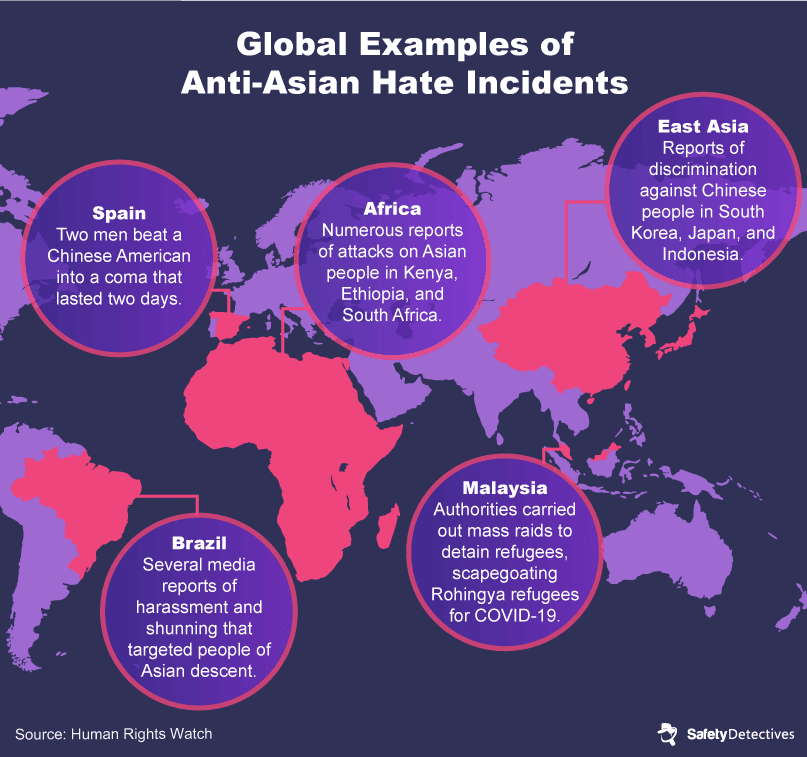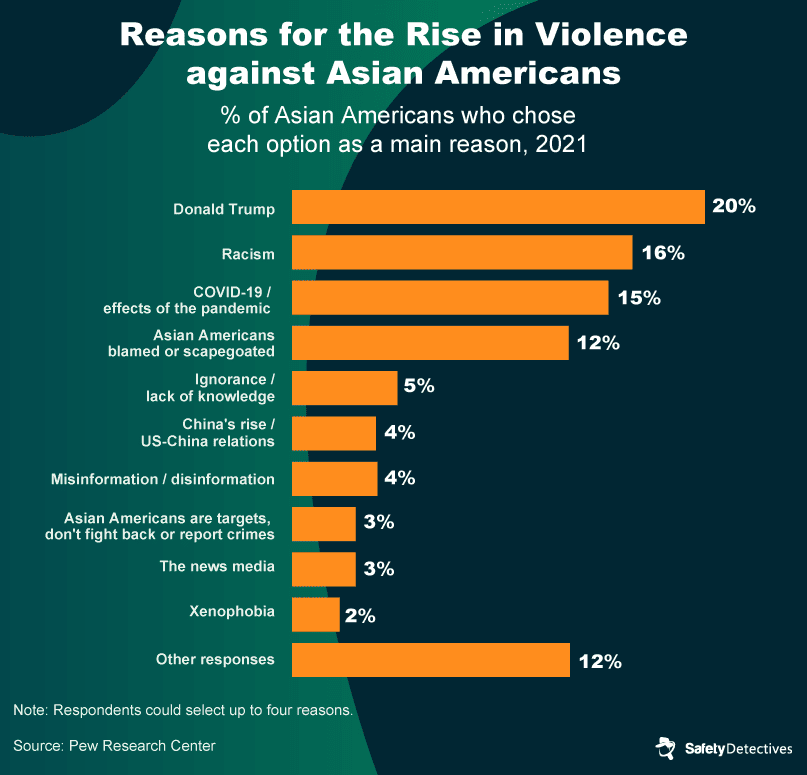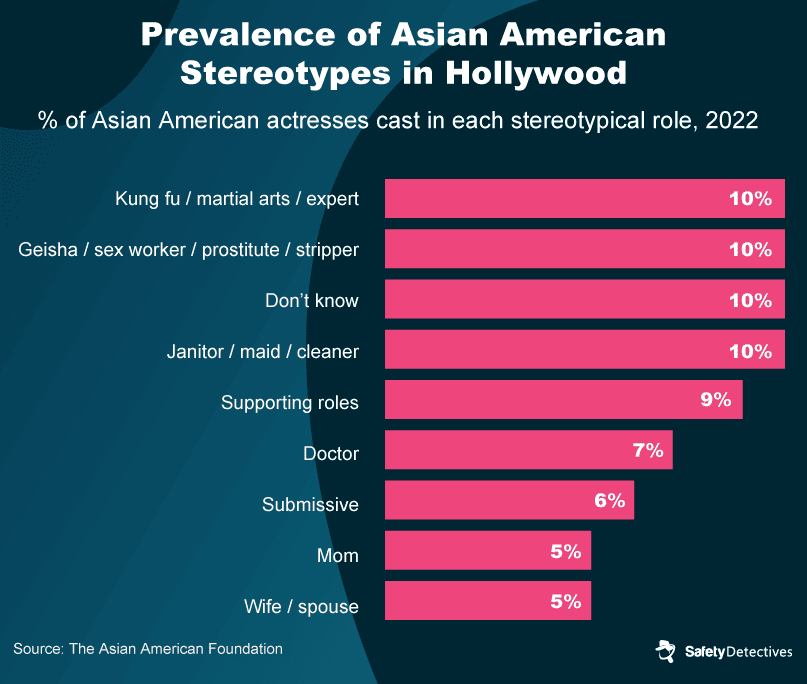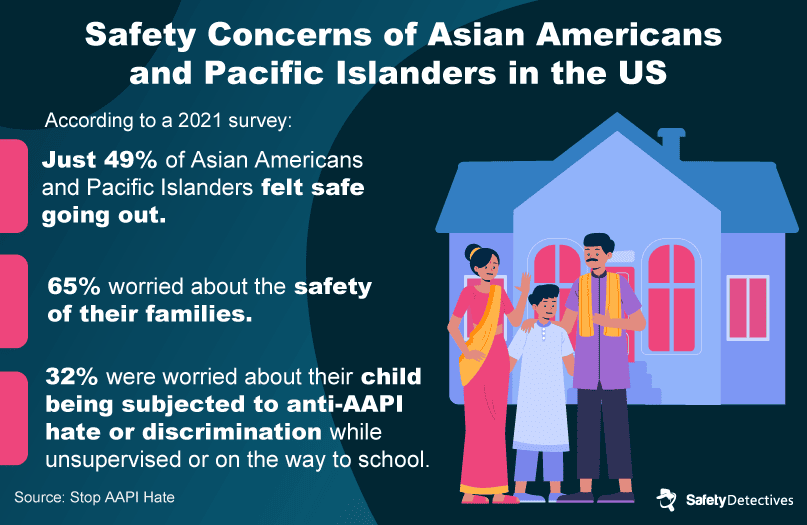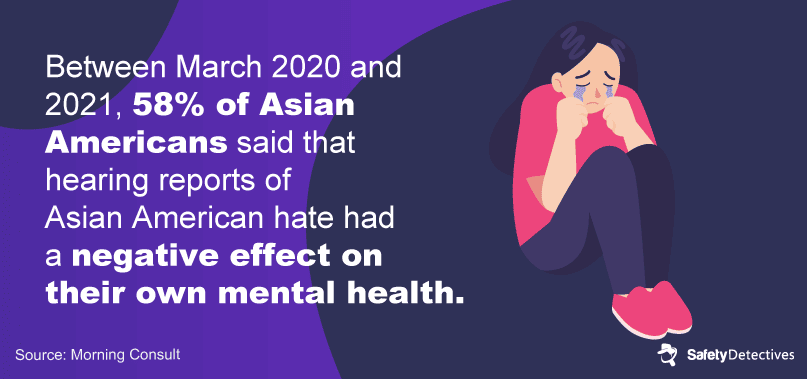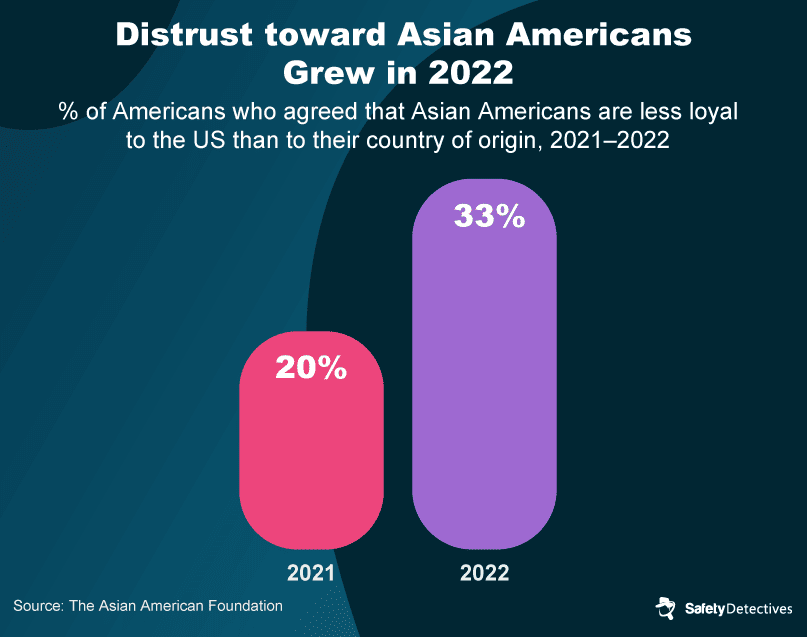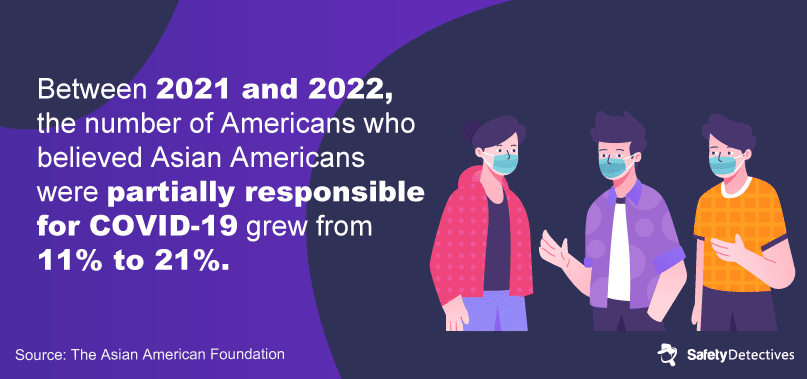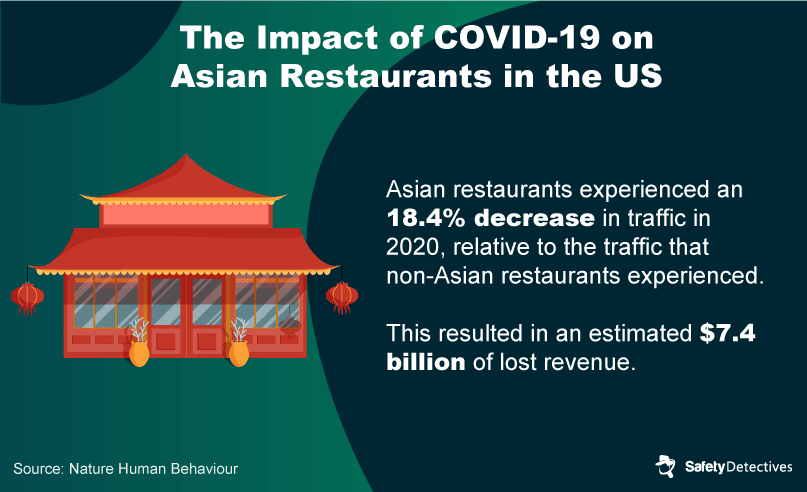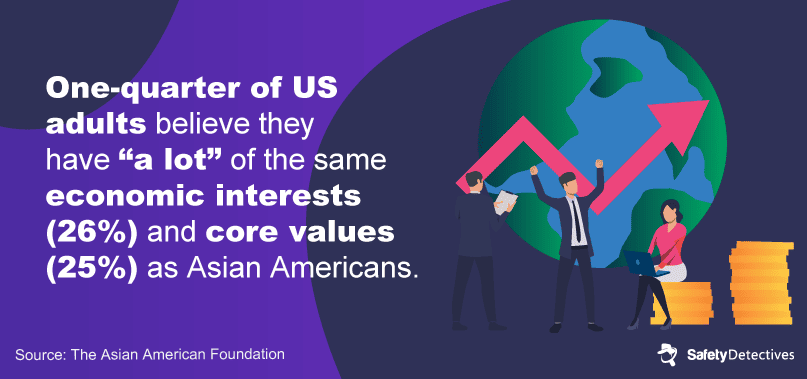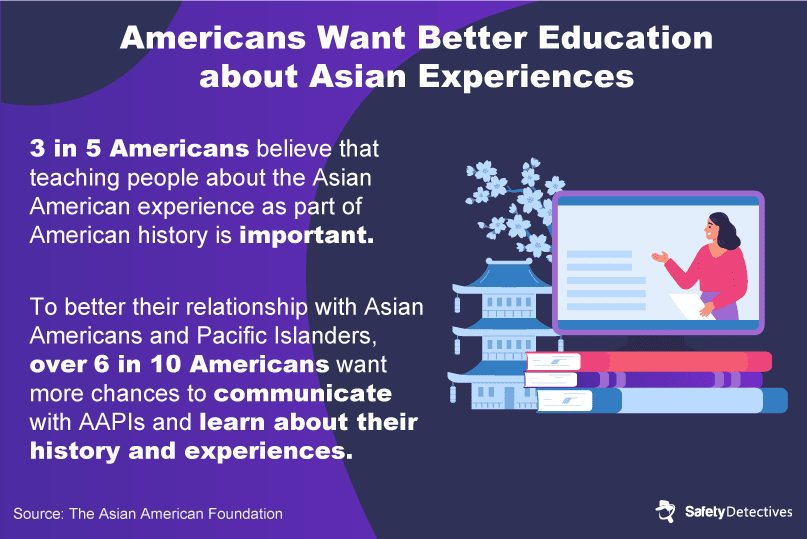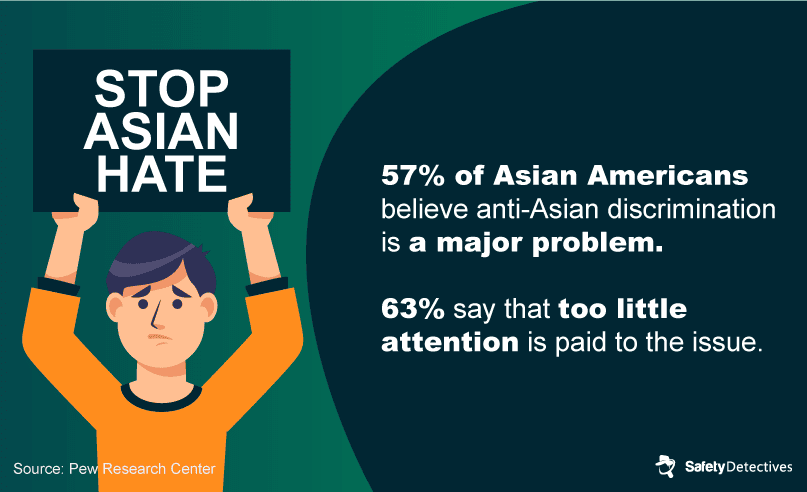
Monica J White
Published on: February 29, 2024
Several years have passed since COVID-19 was declared a pandemic and anti-Asian hate rose dramatically around the world, but anti-Asian sentiment remains a major issue. This type of discrimination, driven by fear and prejudice, likely isn’t going away anytime soon. However, reading and sharing resources such as this one can help to improve the situation.
Educating yourself and others about the scale and impact of ant-Asian hate is the best way to better understand those who experience racism. Sharing information about their experiences helps to uplift their voices, foster compassion, and diminish prejudice or ignorance to the problem.
To help, I’ve compiled 30+ facts and statistics about anti-Asian hate. I’ll cover the history of anti-Asian hate; look at the key trends in where, how, and toward whom it’s perpetrated; and share stats about its causes and impact.
To finish, I’ll explore some of the things we can do as a society to fight back against anti-Asian discrimination.
An Overview of Anti-Asian Hate
Anti-Asian hate refers to any racially-motivated prejudice, discrimination, or hostility that targets Asian people. People of Asian ethnicity or heritage, as well as Pacific Islanders, are subjected to this form of racism.
The following forms of persecution and mistreatment of people of Asian ethnicity can all be examples of anti-Asian hate:
- Discrimination
- Physical assault
- Verbal assault/hate speech
- Violent crimes
- Harassment
- Microaggressions
Anti-Asian hate is most commonly perceived in relation to Asian immigrants’ experience of racism within the West. In the US, anti-Asian hate typically refers to discrimination targeting Chinese, East, and Southeast Asians. In the UK, it also commonly manifests as racism targeting people of South Asian descent.
In many instances, the discrimination felt by Asian people in the West is driven by institutionalized racism. This is because the way in which political, economic, and legal systems have been designed tends to exclude people of Asian or other non-European heritage.
Anti-Asian hate also includes discrimination between people of different Asian ethnicities. Anti-Asian rhetoric within the region is often linked to past geopolitical conflicts and territorial disputes.
For example, in Vietnam, distrust of Chinese people is fueled by centuries of conflicts, including the nations’ relatively recent 1979 border war. The same is true for the Japanese and South Koreans, 90% of whom consider China’s rising military influence as a “bad thing”.
The Difficulties with Anti-Asian Hate Statistics
While there’s plenty of data about anti-Asian hate, it can be difficult to translate this into meaningful statistics. There are a variety of reasons for this.
Underreporting
Much of the data about anti-Asian discrimination and hate crimes is self-reported. Some victims may not report incidents at all, while others may institute false reports or embellish their experience. For example, women are far more likely to report incidents than men, often making it look like one group is subject to more discrimination than another.
Underreporting is particularly common among Asian immigrant communities. Cultural beliefs, such as the idea that they might suffer humiliation or disgrace their families, can be barriers to seeking assistance. Others may unknowingly internalize and accept the racism they experience simply as a part of life.
Fear of repercussions, distrust of law enforcement, and language barriers in filing reports are other common reasons why Asians don’t report their experiences of hate.
Another layer is added when law enforcement agencies come into the picture. There are several reasons why these agencies may not pass all of the reports that they’ve gathered on to the statistical bureaus that aggregate them and publish the data.
Whatever the explanations might be for this lapse in reporting, the effect is that not all anti-Asian hate incidents necessarily form part of hate crime and discrimination data.
Poor Survey Design
The quality of statistics are directly related to the quality of the survey that was used to gather them. Ambiguous, leading, and confusing questions often appear in surveys and can all drive skewed results.
Sample Sizes
Small sample sizes, which can be particularly common when gathering information on the experiences of minority groups, can result in misleading findings. A small sample size will not only skew the appearance of statistics, but can also affect how representative the sentiment is within the broader community.
The History of Anti-Asian Discrimination
Understanding the past is key to figuring out where anti-Asian discrimination stems from. By examining patterns of intolerance that have taken root over centuries, we can better identify effective actions for dismantling the structures and mindsets that perpetuate these behaviors.
1. Timeline of Anti-Asian Hate Incidents Worldwide
Throughout history, people of Asian descent have faced discrimination, violence, and exclusionary laws across the globe.
In the 19th century, the legal system in the United States set a precedent with cases like People v Hall, where Asian witness testimonies were deemed invalid. This era also saw brutal attacks such as the Chinese Massacre in Los Angeles and the Rock Springs Massacre, where Chinese immigrants were targeted and killed.
The Chinese Exclusion Act of 1882 effectively banned Chinese immigration to the US for 10 years. It legitimized the discrimination of Chinese migrants and marked a significant turning point in their treatment by law. As the 20th century kicked off, other countries followed suit, instituting their own anti-Asian laws. Australia’s Immigration Restriction Act, which required those entering the country to write a passage in a European language, effectively excluded Chinese immigrants, while Canada’s Chinese Immigration Act imposed hefty entry fees on these immigrants.
Asians have also been subjected to violence by their fellow citizens. From race riots in Lima, Peru, and the Torreón Massacre in Mexico, to the Kantō Massacre in Japan and the forced relocation of Koreans in the Soviet Union, people of Asian ethnicity have often been treated cruelly.
The internment of Japanese Americans during World War II stands as a particularly dark chapter in American history, with over 100,000 individuals unjustly detained. Post-war, discrimination persisted with events like the Chinese Massacre of 1969 in Malaysia and the murder of Vincent Chin in the United States in 1982.
In the 21st century, hate crimes surged following events like the 9/11 attacks and the COVID-19 pandemic. Incidents like the Atlanta shootings and legislative actions, such as the Texas Senate Bill 147 that prevents certain Asian citizens from purchasing farmland, highlight the ongoing struggles faced by Asian communities.
2. Anti-Asian Bias Incidents Spiked in 2021
Even as the COVID-19 pandemic began to ease in 2021, racial discrimination targeting Asian Americans continued to rise.
A release from Berkeley explains that this sustained increase may be caused in part by inflammatory rhetoric around China. Terms like “China Virus” strengthened the association between COVID-19 and Chinese Asians, potentially leading many people to discriminate against Asian people.
Unfortunately, as the pandemic ended, Asian Americans continued to face massively heightened rates of hate in 2022 compared to pre-pandemic levels. The data shows that there’s plenty of work needed to combat anti-Asian hate in the US.
3. Most US Hate Crimes Fell in 2020, but Anti-Asian Hate Crimes Rose 149%
America’s largest cities saw a 7% drop in hate crime rates in 2020. However, anti-Asian hate still increased by 149% across the cities studied.
It should be borne in mind that the incidence of several different crime types saw decreases during COVID-19 lockdowns because most people stayed inside and had limited social contact. The fact that anti-Asian hate crimes increased during this period indicates just how commonplace anti-Asian sentiment became during 2020.
4. Online Harassment Rose among Asian Americans in 2021
Online harassment targeting Asian Americans rose drastically between 2020 and 2021. This unfortunately comes as no surprise. With anti-Asian hate rising across the US during COVID-19, it makes sense that bigots also turned to online platforms to spread anti-Asian rhetoric.
According to the Anti-Defamation League’s (ADL) analysis, most Asian people report experiencing online hate speech and harassment on Facebook (75% of respondents), followed by Twitter and Instagram (24% each).
Unfortunately, hate speech and harassment posted through these platforms can reach significantly greater audiences than harassment in everyday life. This can serve to magnify its impact and effects.
Who Is Affected by Anti-Asian Hate?
Unraveling the impact of anti-Asian hate requires diving into the varied experiences of the victims of these incidents. People of all Asian ethnicities face a variety of intolerance that affects their day-to-day lives, but some groups are more regularly and drastically mistreated than others.
5. Nearly One-Third of Asian Americans Have Experienced an Anti-Asian Hate Incident
Nearly one-third of all Asian Americans have reported that they have faced a hate crime at some point. In 2021, 15% experienced incidents, while 8% of Asian Americans experienced hate incidents in the first quarter of 2022 alone.
Given these numbers, it’s unsurprising that the vast majority (83%) of Asian Americans are worried that anti-Asian hate will only increase over time.
6. Asian Americans Experience Discrimination Daily
Asian Americans face discrimination on a daily basis. Many times, these discriminatory acts take the form of microaggressions; i.e. verbal or behavioral affronts that show hostility towards people from a marginalized group.
More than half (54%) of Asian American men and nearly two-thirds (63%) of Asian American women are asked about where they’re from daily. Among Asian Americans, some 37% of men and 44% of women report being treated as though they don’t speak English.
There is also more overt discrimination taking place. Asian American men and women commonly report being called names or insulted (33% vs. 34%), being targeted with offensive gestures (29% vs. 31%), and being coughed or spat on (11% for both genders).
7. More than 5 Million Americans Faced Anti-Asian Hate over 18 Months
Over 20% of America’s AAPI population or—5.12 million Asian and Pacific Islanders—experienced hate incidents across an 18 month period from March 2020 to September 2021. That’s an alarmingly high figure and highlights just how common AAPI hate has become following COVID-19.
8. Chinese People Report the Most Anti-Asian Hate in the US
Anti-Chinese discrimination has been one of the most prominent forms of anti-Asian prejudice in the United States. Sinophobia is a fear and suspicion of China that characterizes the nation, its culture, and its people as hostile, a potential threat that’s trying to destroy the West.
Chinese people report being on the receiving end of hateful acts more often than people with origins in other Asian countries. This may be due in some part to the fact they’re the most populous Asian ethnicity in the US.
While Chinese Americans are often the target of Sinophobia, other Asian Americans are commonly lumped together with people of Chinese descent. Oftentimes, the types of people that harbor racial prejudices are unable to distinguish between Chinese Americans and other Asian Americans, and end up directing their hate towards all Asian Americans as a result.
9. Asian Americans Who’ve Lived in the US Longer Experience More Anti-Asian Discrimination
Nearly 7 in 10 Asian immigrants who arrived in the US as children (generation 1.5 Asian Americans) have experienced discrimination either regularly or from time to time. This number remains relatively unchanged among second and third generation Asian Americans, 66% and 61% of whom have faced the same, respectively.
Interestingly, data indicates that people of Asian descent face racism more often as they and their families become more embedded in American culture. Just under half (45%) of foreign-born Asian Americans who have lived in the country for 10 years or less experience discrimination, while 60% of those who have lived there for more than 21 years report experiencing the same.
10. British Pakistanis Faced the Most Racially Motivated Hate Crimes
Pakistani immigration to the UK increased following the dissolution of the British Empire; particularly in the 1950s and ’60s, as many came in search of work and a better life.
People of Pakistani descent are the UK’s second largest ethnic minority today, and have contributed massively to the country’s culture and development in sectors including healthcare, steel, and textiles.
Racial abuse targeting British Pakistanis became increasingly common in the 1960s as more settled in the UK. Amid fears over immigration, the UK government effectively barred people from the Indian sub-continent from entering the country by the end of the decade, institutionalizing racism towards Pakistanis.
The Types of Anti-Asian Hate
Anti-Asian hate can present in a multitude of ways. From online hate speech to face-to-face verbal harassment and even physical abuse, understanding how anti-Asian hate plays out in reality can help us to build empathy and move towards dismantling discrimination.
11. Harassment Is the Most Common Form of Anti-Asian Discrimination
In a Stop AAPI Hate study, Asian Americans described the incidents of abuse they faced. Harassment (66.8% of reports), avoidance or shunning (16.3%), and physical assault (16.1%) were the three most common forms of discrimination.
Harassment can include hate speech, stalking, bullying, physical gestures (like giving the middle finger), sexual harassment, and several other behaviors. Physical assault includes attacks, victims being threatened, intimidated, or having things thrown at them.
The two least common experiences of racism involved being denied service (4.1%) and barred from transportation (1.1%).
12. Most Online Hate Speech Takes the Form of Slurs or Tropes
Online hate speech can take on a variety of forms. Violent threats are made in 30.8% of incidents, while 61.6% of online hate speech incorporates slurs and tropes. According to Ditch the Label’s study, online hate speech in the UK consists of slurs and tropes more often than online hate speech in the US.
Images—such as offensive memes or hateful symbols—make up a further 7.6% of all hate speech found online. Images can play a huge part in perpetuating and normalizing harmful stereotypes online because of the ease with which they can be shared and the resulting desensitization that can follow.
13. Chinese Australians Face Discrimination, Intimidation, and Physical Abuse
Australia has a massive Asian population: 17.4% of Australians have Asian ancestry according to the nation’s 2021 Census. The country is also home to one of the largest Chinese communities outside of Asia, with 5.5% of its population having some Chinese heritage.
The Land Down Under is home to nearly 1.4 million Chinese Australians. Given that 35% of this demographic reports having faced discrimination, we can conclude that nearly half a million Chinese Australians have experienced this type of anti-Asian hate.
Where Anti-Asian Hate Incidents Occur
Anti-Asian hate is unfortunately all around us. However, getting a better understanding of the settings in which these incidents take place can help us to sharpen our collective awareness of these events. This, in turn, can enable us to be more vigilant and responsive when these incidents occur.
14. Most Anti-Asian Hate Incidents in the US Happen in Public Spaces
Most reported anti-Asian hate incidents happen in public streets and spaces. This should come as no surprise. People are more likely to come across strangers—and therefore potential harassers—in public spaces.
Nearly one-third (31%) of AAPI hate incidents occur in the street or on the sidewalk. Almost one in ten (8%) incidents occur in public parks. Public transport (9%) is another common setting for AAPI hate.
Meanwhile, 27% of incidents occur in places of business, such as grocery stores (10%). One-tenth of incidents happen in private residences. Schools, colleges, and universities are the sites of 18% of incidents.
15. Two-Thirds of Asian Australians Experienced Discrimination at Work
Anti-Asian discrimination in the workplace doesn’t necessarily manifest as overt abuse; it can take the form of an offensive workplace joke or microaggression from a coworker.
People of Asian ethnicity are often discriminated against by being ignored for promotions—a phenomena called the “bamboo ceiling.” In fact, Asians occupy just 3.1% of C-level positions in major Australian companies and institutions despite making up nearly 20% of the population.
Among Asian Australians who are aspiring to reach leadership roles, some 44% claim they face discrimination and 42% experience stereotyping based on their ethnicity.
16. Vancouver Experienced Far More Anti-Asian Hate than Its US Counterparts
Vancouver was the North American city with the most anti-Asian hate crimes, seeing three times as many as New York City—with some experts even suspecting that this number may be an underestimate.
Two other Canadian cities, Montreal and Toronto, also feature in the top 5 North American cities for anti-Asian hate. So, why was Canada such a hotbed for anti-Asian hate during the pandemic?
The nation has a history of anti-Asian discrimination. During the early 20th Century, distrust of Chinese immigrants led to several exclusionary laws infringing their human rights. Meanwhile, over 90% of Japanese Canadians were detained during World War Two.
Vancouver, in particular, has a legacy of AA hate due to its geographic location and history of Asian immigration—the most notable event being the Pacific Coast anti-Asian riots in 1907.
17. US Anti-Asian Hate Reports Are Highest in California
California is the state in the US with the highest number of anti-Asian hate incidents reported.
Even when adjusting data from the five states in the US reporting the most anti-Asian hate to account for population, the Golden State still tops the chart. It sees 0.011 incidents per 100 people, while Texas comes out with the lowest rate among the top five at 0.0014 incidents per 100 people.
California and New York’s coastal locations mean they’ve historically received high numbers of Asian immigrants. This possibly explains why these two states rank highest for anti-Asian hate incidents in the US.
18. Incidents of Anti-Asian Hate Emerge around the World
All over the globe, Asians and Chinese people in particular were on the receiving end of a lot of scapegoating and vitriol soon after the breakout of COVID-19. Incidents of harassment, violence, shunning, and xenophobia emerged during this time.
Some of these came from authorities, with world leaders in places like the US, Brazil, and Italy casually mocking the Chinese for spreading the pandemic, normalizing these sentiments among the public.
What Are the Drivers of Anti-Asian Hate?
During COVID-19, anti-Asian sentiment rose sharply in the West. This was partly motivated by misinformed rhetoric that blamed Asians for the spread of the virus and partly driven by the longstanding racist stereotypes perpetuated about people of Asian ethnicity.
19. One in Five Asian Americans Believe Donald Trump Incited an Increase in Anti-Asian Hate
Among surveyed Asian Americans, one in five cited Donald Trump as a reason for the spike in anti-Asian violence.
However, many surveyed Asian Americans believed that the ingredients for the increase in AA hate already existed, such as racism (16%), COVID-19’s origins in China (15%), and tense US-China relations (4%). The belief is that Donald Trump’s rhetoric and language simply exacerbated these sentiments, rather than caused them.
20. Elected Officials Normalized Referring to COVID-19 as the “China Virus” 
The term “Chinese Virus” was first used by Secretary of State Mike Pompeo on March 7th, 2020. By March 9th, online news articles saw an 800% increase in the use of the phrase and related terms like “Wuhan virus” and “China virus.”
A week later, Trump posted a tweet referring to COVID-19 as the “China virus.” In the following week alone, there were 151,716 mentions of that term online, suggesting that the consistent exposure to the term from the media and elected officials normalized its use.
21. Hollywood Casting Perpetuates Stereotypes and Negative Sentiment about Asian American Women
Asian actors often have to play Asian characters that lack depth and complexity, and are built on harmful stereotypes. Roles like martial arts expert (10% of Asian actresses); sex worker (10%); or janitor, maid, or cleaner (10%) have been popularized for the Western gaze.
These portrayals characterize Asians as un-American and reinforce tired tropes—like Asian women are exotic, overtly sexual, or submissive—that have long been held in popular culture. Reducing Asians to their stereotypes in this way misrepresents them as something they’re not.
The Impact of Anti-Asian Discrimination
Aside from feeling othered by their communities, victims of hate crimes are likely to experience a wide range of adverse effects on their mental health, including anxiety, depression, and a desire to withdraw from society. Fearing for one’s safety, in particular, induces an immense amount of mental and physical stress.
22. Anti-Asian Hate Has a Real Impact on Well-being
More than four in 10 Asian Americans say racism has a devastating impact on their mental health.
Various studies have shown that victims of racism often report experiencing depression, stress, anxiety, post-traumatic stress disorder (PTSD), and suicidal thoughts. One study in particular, which assessed Asian Americans’ experiences of hate during COVID-19, found self-harm and substance abuse were also prevalent among victims.
Mental health issues like anxiety can lead to social isolation, which is also an indicator of lower life satisfaction. Sufferers of discrimination may also feel estranged from the community around them and are therefore less likely to foster meaningful connections.
23. Asian Americans and Pacific Islanders Often Fear for Their Safety
Asian Americans and Pacific Islanders often report feeling worried about the safety of themselves and their families. This is understandable in light of the many examples we’ve seen in recent years of how anti-Asian discrimination can quickly turn into violence through no escalation on the victim’s part.
Children and the elderly can be particularly vulnerable to such attacks. In early 2021, Vicha Ratanapakdee, an 84-year-old Thai American, was one of several elderly Asians who fell victim to violent attacks that year. Similar hate crimes have targeted Asian children, including an attack in Texas where the perpetrator attempted to kill a 6 year-old child.
24. Asian Americans Have Experienced Stress and Worsening Mental Health from Anti-Asian Hate
Many surveyed Asian Americans report worsening mental health and anxiety about the increase in anti-Asian sentiment throughout 2020 and early 2021.
This comes as no surprise—even major media outlets and high-ranking elected officials casually used terms such as “China virus,” fanning the flames for people scapegoating Asians for COVID-19.
25. Americans Question the Loyalty of Asian Americans
By many accounts, anti-Asian hate decreased slightly in 2022. Despite this, however, we see above that increasingly many Americans are questioning where the loyalties of Asian American people lie.
Distrust of Asian Americans rose among US citizens in 2022 as many continued to wrongly blame Asians for the pandemic. Rhetoric scapegoating the Asian community and spreading distrust continued in 2022, even from members of congress.
Within this context, it’s no surprise that less than one-third (29%) of Asian Americans “completely agree” that they feel they’re accepted in US society.
26. Americans Increasingly Blamed Asian Americans for COVID-19
World Health Organization (WHO) officials intentionally named COVID-19 in a way that attempted to prevent stigmatizing any particular group. But even though the organization advised the public not to attach any specific ethnicity to the virus, the media propagated an image tied to anti-Asian sentiment.
It did this by repeatedly emphasizing its purported origins in a Wuhan wet market, while using anti-Chinese terms such as the “Chinese virus.” While the virus did in fact originate in Wuhan, the way in which this information was delivered served mainly to drive anti-Asian sentiment.
27. Americans Disproportionately Avoided Asian Restaurants during COVID-19
Many Asian restaurants suffered from a huge downturn in business during COVID-19. With a portion of the general public blaming Asians for the virus, many began avoiding Asian businesses by association.
Asian restaurants suffered far worse than other cuisines with traffic decreasing nearly 20% compared to other restaurants. Interestingly, areas with higher levels of support for Donald Trump showed even more avoidance of Chinese food establishments, suggesting that the fear was indeed worsened by a general anti-Asian sentiment.
Hope for the Future: Improving Attitudes Towards Asian People
The numbers around anti-Asian sentiment haven’t been entirely positive over the past few years. That said, there’s a definite indication that other Americans are recognizing more and more the values they share with Asian Americans. This offers hope that we’ll be able to increase understanding and acceptance to foster inclusivity.
28. AAPI Representation in Media Has Improved since 2020
While the data shows that Asian American representation is increasing in recent years, Asians are still underrepresented in leading roles. According to a 2023 Hollywood Diversity Report, just 2.3% of leading characters in theatrical films are Asian.
Movie executives cling to the idea that Asian actors won’t sell films. But recent successes, like the record-breaking rom-com Crazy Rich Asians, prove this not to be true.
The lack of Asians in leading roles means there aren’t many role models on screens for young Asian Americans. Asians don’t see themselves represented in popular culture, and the subtext here is that they don’t really belong in American culture at all.
Improving the quality and quantity of Asian representation could halt the perpetuation of harmful stereotypes that inform America’s perception of Asians, and Asians of themselves. Instead, better representation could promote diversity and offer a sense of belonging to many Asian Americans.
29. Americans Find Common Ground with Asian Americans
A quarter of Americans recognize the economic and moral values they share with Asian Americans. These statistics signal a major opportunity for building common understanding and connections between AAPIs and other members of the US public in the future.
30. Americans Are Open to Improving
Education is one of the most important methods for eradicating racism. It can help deconstruct the discriminatory narratives, discourses, and stereotypes that people disseminate about a particular group. Education can also help foster a cultural exchange, building compassion and understanding between one group and another.
Most Americans (60%) understand the importance of learning about the Asian American experience and want to have more opportunities to further their understanding. The statistics suggest most Americans realize they don’t know enough about the issue, and are willing to do better.
How to Help Fight Anti-Asian Hate
Confronting and dismantling anti-Asian hate demands collective action. Whether you’re an Asian or an ally, fostering understanding and raising awareness is paramount for creating a global shift towards lasting positive change.
31. Awareness Isn’t Where It Should Be
Most Asian Americans believe that anti-Asian hate is a significant issue that’s largely ignored. The lack of awareness around Asian experiences of hate perhaps points to the broader invisibility of Asians within American culture.
This is an issue because anti-Asian hate can’t become a thing of the past until more people understand and are aware of it. That’s why it’s so important to eradicate anti-Asian sentiment, uplift Asian voices, and spread awareness of Asian experiences within your own life.
Whether you’re Asian, or simply trying to be a better ally, educating others and raising awareness about anti-Asian hate is the most important way to create lasting change. Doing so helps to sow the seeds of compassion and understanding that can eradicate anti-Asian discrimination in people both now and for generations to come.
Although every action each individual takes may feel insignificant, it’s the sum of our parts that can drive awareness on a global scale. Here are the ways you can help fight anti-Asian hate in your everyday life.
- Educate yourself about anti-Asian discrimination. Read about the history of anti-Asian discrimination and the nuances of each ethnicity’s experience. Consider taking bystander intervention training with organizations like Right To Be.
- Speak out when you witness an incident. Look to question the wrongdoer’s behavior and educate them about why it was wrong. However, make sure you stay calm and prioritize the safety of yourself and those around you.
- Report hate crimes or incidents. Call law enforcement immediately if the situation is violent or dangerous. Report the incident to the authorities. If you don’t feel comfortable reporting to the authorities, Stop AAPI Hate and Stand Against Hatred have separate reporting mechanisms. Encourage others to report their experiences too.
- Advocate for awareness of the problem. Whether you’re on social media, in the workplace, or in everyday life, spread information and share resources that educate others about the issue.
- Support organizations that fight anti-Asian hate. Donate to non-profits that resonate with you and consider volunteering for rallies, donation drives, and other in-person events. GoFundMe has a vetted list of fundraisers.
- Campaign against anti-Asian hate. Sign petitions. Take part in peaceful protests to help spread awareness. Contact elected officials about specific bills and votes to help effect change.
- Have the difficult conversations around race and racism with your children. Foster an understanding that some people look differently to them, but it’s not okay to treat them differently. Explain how some people wrongly treat others based on how they look or the color of their skin. Don’t shy away from these conversations and encourage an open dialogue.
The Bottom Line
The wave of anti-Asian sentiment that we’ve seen following the pandemic has drawn attention to the pervasive and multi-faceted nature of racism faced by Asian communities across the globe.
The worrisome realities of anti-Asian hate and its effects indicate that we need not only to acknowledge the depth of this issue, but also foster a more open and inclusive society. In this vein, it’s imperative that we recognize that everyone has a role to play in combating this type of racism.
By uplifting Asian voices and experiences, we can all contribute to creating a more empathetic and understanding world where respect and solidarity prevail.
We must focus on improving attitudes towards Asian people through educating ourselves and others around the challenges they face, and by advocating for fair and meaningful representation in all aspects of life.




